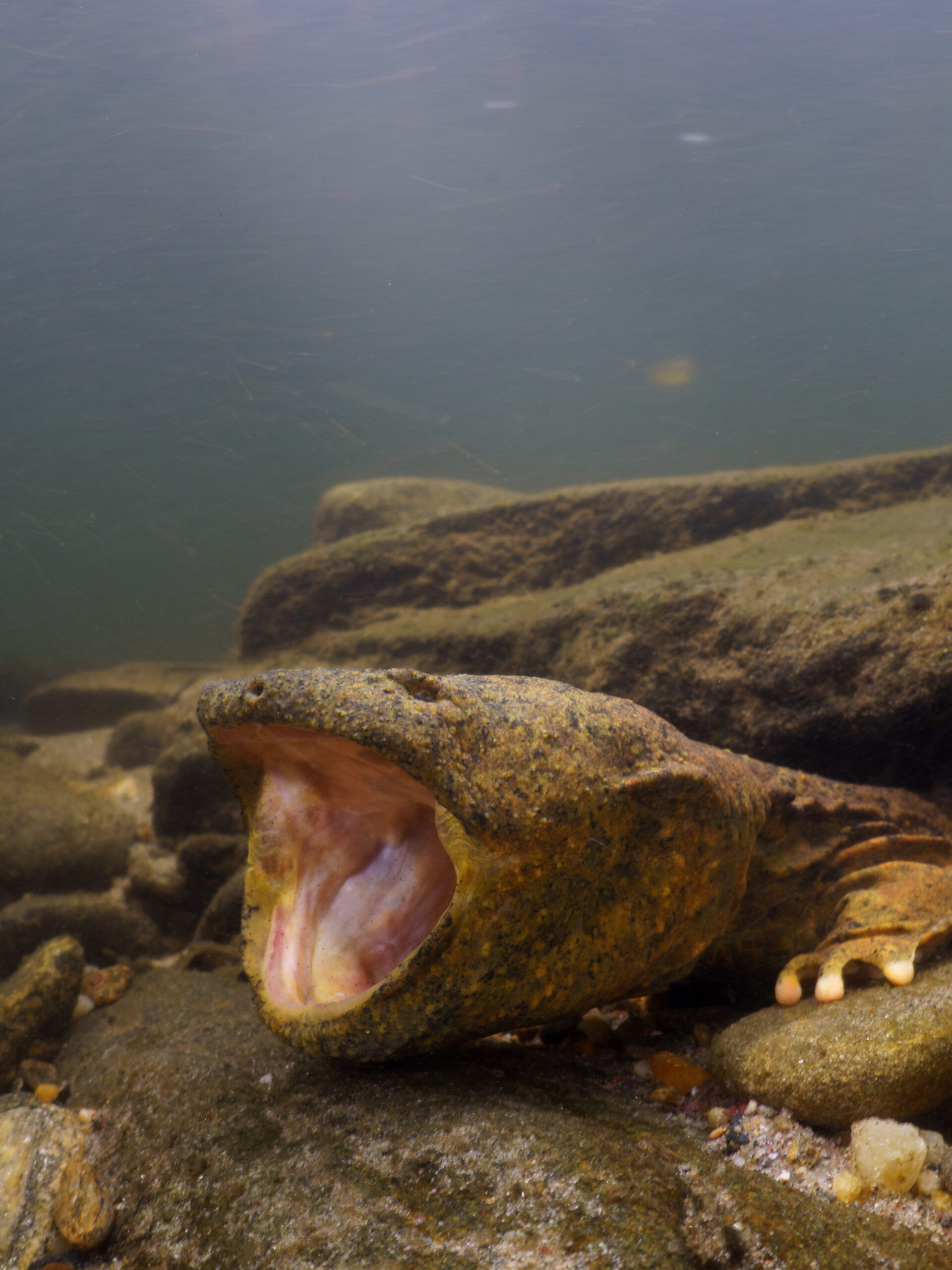Eastern hellbenders were already in trouble, then Hurricane Helene hit
Snot otter. Mud devil. Lasagna lizard.
The eastern hellbender’s evocative nicknames are not necessarily affectionate, but across the Appalachians, the salamander is beloved.
“They’re smooth, long, and kind of magical. They’re perfectly adapted to hide in cool mountain streams. They can be deep brown, green, some even have flecks of gold on them,” said Andy Hill, Mountain True’s High Country Regional Director and Watauga Riverkeeper.
Hill said hellbenders are having a moment.
Hellbenders are so unique to the southern Appalachians, there’s a lot of pride for them, and they’ve captured the public’s imagination. The more we teach folks about them, the more they want to protect them.
Andy Hill, Watauga Riverkeeper
Eastern hellbenders need all the help they can get. They were originally found in mountain and foothill streams from New York through Mississippi. But populations have been in decline since at least the 1940s. Now the Fish and Wildlife Service (FWS) is proposing to classify eastern Hellbenders as an endangered species — a move that will bring much needed attention, education, and resources to aid in their recovery.
Salamander ‘hot spot’
More salamander species live in the Appalachian Mountains than anywhere else on Earth. Many are adorned with bright colors or feathery external gills. Two thirds of salamanders, including hellbenders, are lungless and breathe through their skin.
Hellbenders live most of their lives under rocks in cool, clean mountain streams. They’re both predator and prey – adult hellbenders walk across riverbeds to hunt crayfish at night, and males spend two months in egg nests to protect their young from predatory fish, turtles, and other hellbenders, until they hatch. Young hellbenders use gills for the first two years of their life, then breathe through their skin. In fact, hellbender’s signature wrinkles are an adaptation to increase the surface area they can breathe through.
Meet the salamanders making the South a biodiversity hotspot
“The South is a salamander hotspot. But many of the hellbender’s unique features also make them incredibly sensitive to their environment,” said SELC staff attorney Elizabeth Rasheed. Rasheed led a team that successfully pushed the FWS to reconsider denying endangered species protections for the incredibly rare Berry Cave salamander in Eastern Tennessee.
In support of the proposed eastern hellbender listing, SELC on behalf of a broad coalition of 39 conservation groups, including Mountain True and Watauga Riverkeeper, wrote a letter to FWS. The letter explains the increasing pressure eastern hellbenders face because of climate change and habitat loss impacts, including deforestation and water pollution.
“If a stream becomes polluted, or muddy from runoff, hellbenders and many other creatures in that stream can’t breathe,” said Rasheed. She explained that because of overdevelopment, heavy rain carrying silt and pollutants are going directly into many waterways. “Forest and wetlands filter pollutants and slow water before it reaches streams and rivers. Too much concrete and asphalt turn heavy rains into floods, and floods into catastrophe.”
Hellbenders and hope

Western North Carolina was considered a hellbender stronghold. Rivers across the region, including the Watauga and Upper French Broad rivers, were home to comparatively stable populations. Then Helene hit.
The September 2024 tropical storm brought up to 31 inches of rain to some places, setting record breaking flood levels for several rivers. Months later, communities across Appalachia are still recovering from the catastrophic damage.
“We went from riverkeepers to search and rescue or critical needs delivery. We were getting supplies to folks by boat, ATV, or truck,” Hill said. He quickly found that people were not the only ones facing critical needs after the storm. “When we went back to monitoring water quality, we discovered a great number of hellbenders were displaced by the flood.”
Catatonic hellbenders were found more than 50 feet from the river. Hill said they were found in flooded homes and mud. One was in a church basement.
“People started calling us, saying ‘hey where’s the best place to take this hellbender? We just found three more,’” Hil said. “Getting hellbenders back to the river gave people hope.”
While the number of stable eastern hellbender populations across Western North Carolina after Helene is unknown, the community’s support for more action to protect the salamander is clear. Last year, the North Carolina town of Boone funded a local artist to paint a hellbender mural downtown. In January, Boone passed a resolution in support of listing the hellbender as endangered. This month, Buncombe County passed a resolution of their own.

“The Endangered Species Act is an incredibly popular and powerful conservation tool,” Rasheed said. “For more than 50 years, the ESA has protected 99 percent of species listed as threatened or endangered from extinction. You don’t often see partnership across state and federal agencies get better results than that.”
If Western North Carolina can start to recover, with the help of the Endangered Species Act maybe the hellbender can too.
